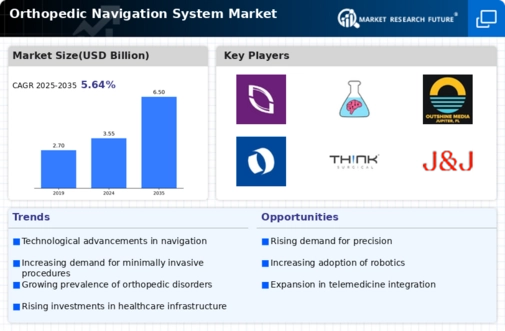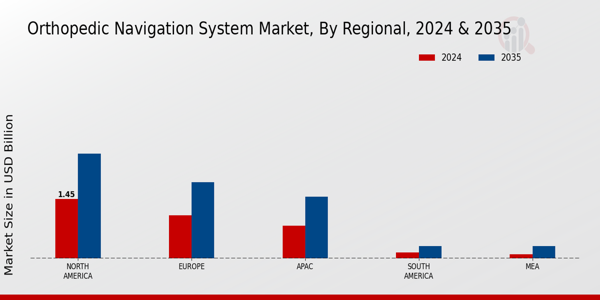Technological Advancements
The Global Orthopedic Navigation System Market Industry benefits significantly from ongoing technological advancements. Innovations such as augmented reality and robotics enhance surgical precision and patient outcomes. For instance, systems integrating 3D imaging and real-time data analytics allow surgeons to visualize complex anatomical structures during procedures. This technological evolution is expected to drive the market's growth, with projections indicating a market value of 3.55 USD Billion in 2024, potentially reaching 6.5 USD Billion by 2035. Such advancements not only improve surgical accuracy but also reduce recovery times, thereby appealing to healthcare providers and patients alike.
Increased Healthcare Expenditure
Rising healthcare expenditure across various regions is a significant factor propelling the Global Orthopedic Navigation System Market Industry. Governments and private sectors are investing heavily in healthcare infrastructure, which includes the adoption of advanced surgical technologies. For instance, countries are allocating larger budgets to improve surgical facilities and equipment. This trend is expected to enhance the accessibility of orthopedic navigation systems, thereby driving market growth. As healthcare spending continues to rise, the market is likely to expand, reflecting the increasing prioritization of advanced medical technologies in patient care.
Enhanced Training and Education Programs
The Global Orthopedic Navigation System Market Industry is also influenced by enhanced training and education programs for healthcare professionals. As surgical navigation technologies evolve, the need for skilled practitioners becomes paramount. Institutions are increasingly offering specialized training that focuses on the effective use of these systems. This emphasis on education not only improves surgical outcomes but also fosters greater confidence among surgeons in utilizing advanced technologies. Consequently, the market is expected to benefit from a more competent workforce, which may lead to increased adoption rates of orthopedic navigation systems.
Rising Incidence of Orthopedic Disorders
The increasing prevalence of orthopedic disorders globally serves as a crucial driver for the Global Orthopedic Navigation System Market Industry. Conditions such as osteoarthritis and fractures are becoming more common, particularly among aging populations. According to data, the global elderly population is expected to rise significantly, leading to a higher demand for orthopedic surgeries. This trend suggests that the market will experience sustained growth, with a projected compound annual growth rate (CAGR) of 5.65% from 2025 to 2035. As healthcare systems adapt to these demographic changes, the adoption of advanced navigation systems will likely become more prevalent.
Growing Demand for Minimally Invasive Surgeries
The shift towards minimally invasive surgical techniques is a notable trend influencing the Global Orthopedic Navigation System Market Industry. These procedures typically result in reduced postoperative pain, shorter hospital stays, and quicker recovery times. As patients increasingly prefer these options, healthcare providers are compelled to adopt advanced navigation systems that facilitate such surgeries. The market is poised for growth, with estimates indicating a rise from 3.55 USD Billion in 2024 to 6.5 USD Billion by 2035. This demand for less invasive procedures aligns with broader healthcare goals of improving patient experiences and outcomes.





















Leave a Comment